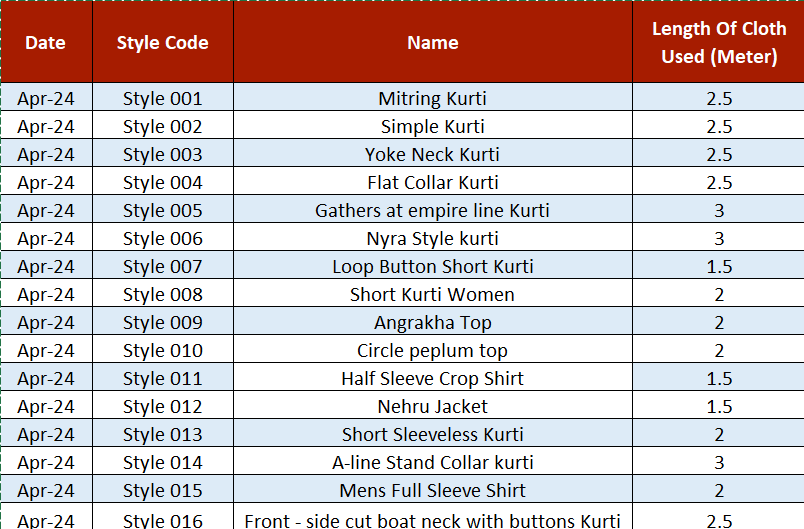Kala Maitri is a collective-run social enterprise focusing on apparel and fabric products, which provides opportunities to small-scale livelihood women weavers and garment manufacturers. With its launch in 2019, the enterprise has developed a formal inventory system to record the data and activities of the business. The system may appear a bit lengthy; but it has its own simplicity. Therefore the women who are part of the enterprise understand it easily.
Here you go with understanding and contemplating how a group of women, one would assume do not ‘understand much’ can manage a comprehensive inventory management processes.

Product Coding
(H.1) Unique Coding System
(H.1.1) Style Code
(H.1.2) Raw Material Code
(H.1.3) Finished Goods Code
Kala Maitri uses a unique coding system to record all raw material purchases and finished goods. Since Kala Maitri operates in garment manufacturing, maintaining accurate data on garment styles is crucial. We record the styles produced at the centre using a three-digit numbering format. A style sheet documents this information and maintains it in an excel file. Each month, we print and provide an updated version of the style sheet to the Kala Kendra (craft centre) as a physical record.


Material Purchase Register
Each fabric design has a unique code. We record this information in the ‘raw material purchase register.’ We maintain the corresponding digital data for these purchases in an excel sheet. The unique code is written in the following format:
KM_MHS_(3-digit number code)
- KM stands for Kala Maitri.
- MHS is a 3-letter alphabetical code assigned to each centre. Currently, Kala Maitri operates six centres, each with its unique code. For example, Ujjain is assigned the code UJJ, Bhopkhel is assigned the code BHP etc. Here, MHS represents Maheshwar
- The 3-digit number code identifies new fabric designs purchased at the centre. For instance, the red fabric in the image below is the 201st design, while the cream one is the 195th. All other designs are numbered sequentially in this manner
When the production of a garment is completed, it gets another unique code for record-keeping. The codes follow this format:
KM_MHS_(3-digit style code)(1-letter size code)(2-digit serial number)
- KM and MHS stand for Kala Maitri and Maheshwar, respectively, as in the raw material codes
- The 3-digit style code corresponds to a specific design, taken from the style sheet mentioned earlier
- The 1-letter size code indicates the garment size:
- E for Extra Small
- S for Small
- M for Medium
- L for Large
- X for Extra Large
- D for Double Extra Large
- T for Triple Extra Large
- The 2-digit serial number is a unique identifier for each garment in the production sequence, ensuring the code remains distinct.
Price Tag
These codes are printed on the garment’s price tag, and attached using a tying thread.

Backend Processes
(H.2) Record Registers
(H.2.1) Work Allocation Register
(H.2.2) Inventory Register
(H.2.3) Silai Baithak Register
(H.2.4) WEN Member List
The work allocation for the women is recorded in a register called Sadayawar Karya Avantan Aur Avlokan (member’s work allocation register). This register tracks the raw materials assigned to each woman and the number of products expected from them. Another section is used to record the actual products they complete and submit. Hence, this system helps compare the raw material requirements for different product styles.

After production, we record the products in the Vastusoochi (Inventory) Register using their unique codes.

Additionally, we document the inventory in an excel sheet, where we regularly update the status of each finished product. We assign the finished goods the following status :
- Defective
- Incomplete
- In Stock
- Issued to Maitri
- Opening Stock
- Order
- Sample
- Sold
We promptly update any changes in the status of finished goods in the excel sheet inventory.

Silai Baithaks
The women meet twice a month for meetings called Silai Baithaks, which are crucial for making all key decisions. In this image, you can see the Mahila Udhyami Sangathan Masik Baithak (WEN monthly meeting) Register – shortly also called Silai Baithak Register, divided into sections based on work activities, with decisions recorded accordingly. Each meeting set consists of four pages, and the last page records the attendees.
WEN, or Women Entrepreneurial Network, is a group of women with similar skills who come together to collaborate, train, and mentor each other. Therefore, Kala Maitri forms a WEN of women skilled in stitching and tailoring, known as the Silai WEN. Women join the WEN by registering and begin contributing based on their knowledge and expertise. Upon joining, each new member gets a Sadasyata Patra (membership certificate). The names of all current WEN members are in the WEN Sadasya Soochi (members’ list).






0 Comments